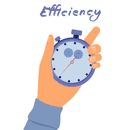Common Challenges Faced by Scrum Teams
Scrum is a simple and lightweight Agile methodology but does come with real-life challenges that most of the Scrum teams have to deal with at different stages.

Scrum seems simple to set up and a lightweight Agile methodology that organizations can easily get started with, but it's not that straightforward to master. Scrum does promise enhancements in the overall team's speed, problem-solving skills, quality products, and timely deliveries. However, there are many real-life challenges that Scrum teams have to deal with as they adopt the Scrum framework. In this article, we will discuss some of the most common challenges faced by the Scrum teams.
10 Common Challenges Faced by Scrum Teams
No matter the size or nature of the Scrum team, there are always a few sets of challenges the teams have to deal with when they are trying to leverage Scrum to expedite business value. Here's a look at 10 common challenges that most Scrum teams face during their Scrum-oriented development journey:
1. Resistance to Change
The very first challenge Scrum teams face is the resistance to change. It is always a struggling hassle to change organizational culture to something different that most employees are not well-educated about. Moreover, it becomes a bigger challenge if the organization is already having success with the traditional approach.
Scrum requires an organization to change its quarterly or half-yearly releases to weekly-based iterative releases, thereby demanding a complete shift in the development approach. Employees who don't want to disrupt their current routines or are unfamiliar with potential outcomes with the Scrum framework show significant resistance. So, the first challenge for Scrum teams is to bring everyone on board and address the resistive comments with convincing answers.
2. Struggle Creating Releasable Product Every Sprint
Scrum requires that after every sprint session, the team delivers a releasable version of the product. However, often teams struggle to create a releasable product version every sprint due to challenges mentioned in this article or other challenges raised due to organizational level Scrum adoption. Whatever hurdles block the team to create a releasable product, the Scrum Master and the Team have to fight through them and try their best to deliver a releasable product version every sprint.
3. Unavailability of Product Owner
In Scrum, the Product Owner has a key role to play, as he manages the product backlog and tries to maximize the product's value. However, many teams are found to struggle with the unavailability of the Product Owner. If the Product Owner is not engaging with the team properly and contributing its inputs in team meetings, then the team will not be able to proceed with the product backlog in an optimal way. Therefore, an organization must ensure continuous availability of the Product Owner to the Scrum team.
4. No to Minimal Access to Key Stakeholders and Users
Since organizations have long been practicing Waterfall methodology, they don't properly acknowledge the value direct access to key stakeholders and users can bring to the development team. However, it is important for the Scrum team to have direct access to the users (in case they belong inside the organization) or have direct access to user analytics (in case they belong outside the organization). When a Scrum team has access to key stakeholders and users, the team can get direct and quick feedback from them during release planning, sprint review, and similar other stages.
Most of the time, teams struggle when it comes to accessing users. In fact, Product Owner unavailability along with no access to users make the team blind about the product business value. This can in turn compromise the product quality and significant loss of resources. Therefore, it is important for an organization to make key stakeholders and users accessible to the Scrum team.
5. Struggles with Sprint Length
There is no such thing as a standard or perfect sprint length. As per the Scrum rule, the sprint length should not exceed 4 weeks. The ideal length of the sprint is between 2-3 weeks. The sprint length is decided by the Scrum team based on the efforts required to deliver that sprint. However, teams are seen struggling with inadequate sprint duration, especially those teams that are new to the Scrum framework. Usually, unexpected hurdles, improper estimation of sprint length, or slow progress from some members lead to this problem. The two possible ways to address this challenge include using previous sprints as a reference while estimating the length of similar sprints and adding some extra time to the sprint to address uncertainties.
6. Lack of Training
As discussed above, Scrum seems easy to implement, but it is difficult to master. Some organizations don't emphasize training and think that teams will get familiar with basic Scrum principles as they proceed. However, it is vital to make sure that all the participants are familiar with how Scrum works because Scrum works perfectly when there is a team of experts. Therefore, it is important to have an experienced Scrum Master and Product Owner, while the remaining team must be familiar with Scrum working concepts.
7. Inefficient Daily Stand-Up Meetings
As per Scrum, the development team must conduct daily stand-up meetings for 15 minutes to evaluate progress and ensure team collaboration. However, this "15 minutes" does not always end at the exact 15th minute. It can even last for more minutes. For example, consider a Scrum team of 9 members and each member takes up 3-4 minutes during that stand-up meeting. So, it means a total of 30-36 minutes of the day are spent on just one meeting.
Although the concept of the daily stand-up meeting is to ensure team communication, these extra minutes spent on meetings impact the productivity of members. So what teams should do is they must practice daily stand-up meetings, but try to keep it strictly within 15 minutes range.
8. Urgent Tasks/Bugs Between a Sprint
Scrum iterative approach is meant to encourage the model of continuous development and continuous testing driven by continuous feedback. This way, bugs can be identified earlier, while products can be better tailed as per users' expectations. But what about an urgent request or crucial bug that pops up during a sprint? One solution is to deal with it in the next sprint, but sometimes such issues need instant attention, especially when the product is in its final stage. This means that members have to stop what they are doing and address the request, which can disrupt the current sprint cycle. However, it is seen that teams now allocate some extra time in a sprint session to accommodate any urgent requests they might have to fulfill in-between the sprint session.
9. Need of Extensive Market Research
Since different teams have different target audiences, their market research also differs. So, another challenge some Scrum teams face is the need for more extensive research to understand the target audience/market, especially when the product is targeting the general public. The possible solution to this problem is to have separate market researchers who conduct comprehensive research and then update the Scrum team with their findings.
10. Challenges During Product Backlog Estimation Sessions
A product backlog estimation session is usually conducted with key stakeholders, such as developers, Product Owner, designers, product managers, QA testers, etc. Estimation techniques, like Planning Poker, T-Shirt Sizing, Affinity Mapping, and similar others are used to do estimates of product backlog items. However, there are some common challenges that teams face during these estimation sessions, such as:
- The session cannot begin until all the members have joined.
- Every member has to understand the items to be estimated and then present individual estimates. However, newcomers or slow learners often find it difficult to understand and provide estimates instantly, thereby compromising the overall team's estimate.
- Some members might be busy with other important tasks, but they have to stop what they are doing and come attend the meeting, thereby compromising their productivity.
There can be other challenges too that teams might face during product backlog estimation sessions. The best remedy for these challenges is to orient the session that fits with your organization's operational framework. For example, teams are now seen practicing the Asynchronous Planning Poker (or Async Poker) estimation technique that addresses most of the above concerns.
In the Asynchronous Planning Poker technique, the moderator sends the items to be estimated to the members via email or other channels and gives them the deadline until when they have to send the estimates. The members understand the items at their own pace and send their estimates before the deadline. Afterward, they can have a quick-brief discussion session to finalize the overall team's estimate. This way, not just the process becomes time-efficient, the productivity of members is also not compromised.
Wrapping Up
Scrum brings collaboration, user-focused iterative development cycles, and better-quality releases. However, Scrum also brings many challenges for an organization. But it does not mean organizations should show resistance towards adopting Scrum. Challenges are the part of business and what matters is how you deal with them. So, if you are planning to shift to the Scrum framework or already using it but struggling with challenges, then stay still and look for solutions. Just as every darkness has its own light, every challenge has its own solution that you have to look for.





